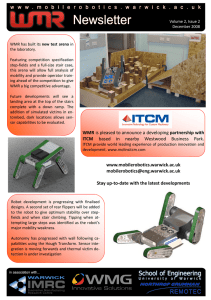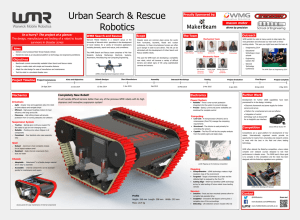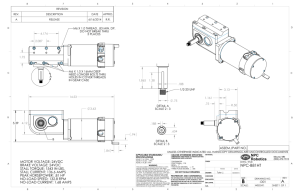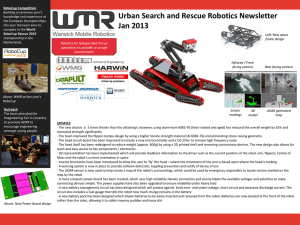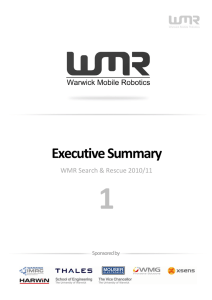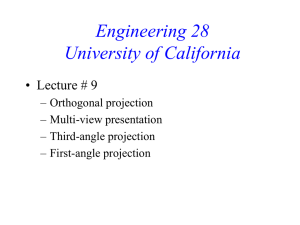ROBUST INTELLIGENT ACTIVE FORCE CONTROL OF NONHOLONOMIC WHEELED MOBILE ROBOT ,
advertisement
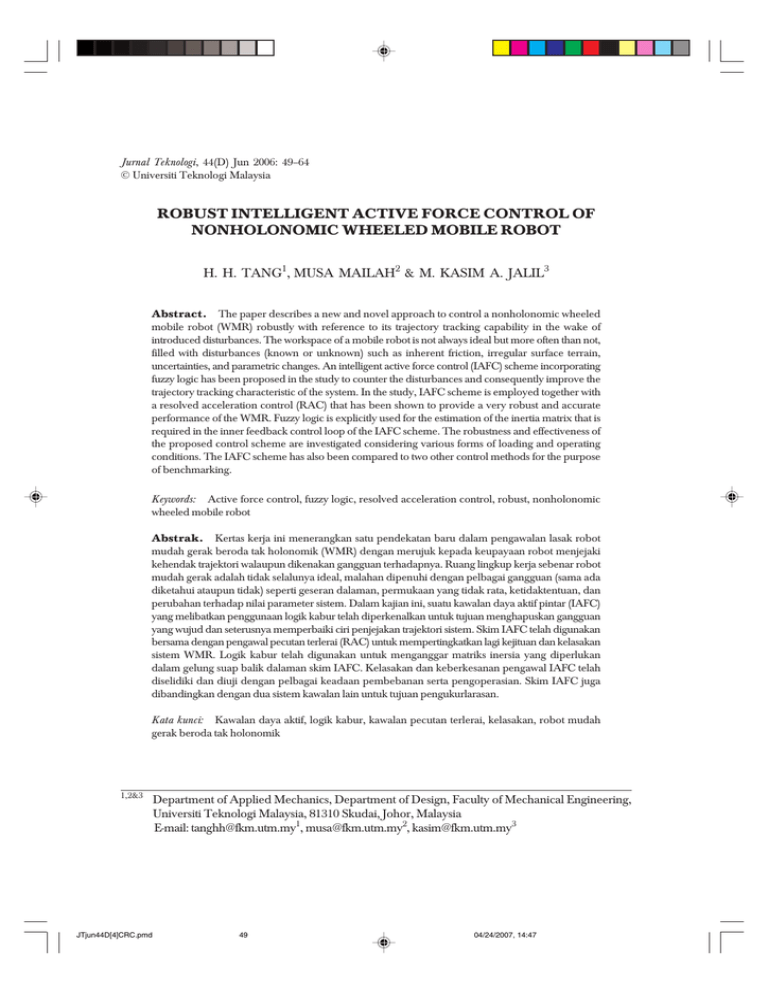
ROBUST INTELLIGENT ACTIVE FORCE CONTROL OF NONHOLONOMIC WHEELED 49 Jurnal Teknologi, 44(D) Jun 2006: 49–64 © Universiti Teknologi Malaysia ROBUST INTELLIGENT ACTIVE FORCE CONTROL OF NONHOLONOMIC WHEELED MOBILE ROBOT H. H. TANG1, MUSA MAILAH2 & M. KASIM A. JALIL3 Abstract. The paper describes a new and novel approach to control a nonholonomic wheeled mobile robot (WMR) robustly with reference to its trajectory tracking capability in the wake of introduced disturbances. The workspace of a mobile robot is not always ideal but more often than not, filled with disturbances (known or unknown) such as inherent friction, irregular surface terrain, uncertainties, and parametric changes. An intelligent active force control (IAFC) scheme incorporating fuzzy logic has been proposed in the study to counter the disturbances and consequently improve the trajectory tracking characteristic of the system. In the study, IAFC scheme is employed together with a resolved acceleration control (RAC) that has been shown to provide a very robust and accurate performance of the WMR. Fuzzy logic is explicitly used for the estimation of the inertia matrix that is required in the inner feedback control loop of the IAFC scheme. The robustness and effectiveness of the proposed control scheme are investigated considering various forms of loading and operating conditions. The IAFC scheme has also been compared to two other control methods for the purpose of benchmarking. Keywords: Active force control, fuzzy logic, resolved acceleration control, robust, nonholonomic wheeled mobile robot Abstrak. Kertas kerja ini menerangkan satu pendekatan baru dalam pengawalan lasak robot mudah gerak beroda tak holonomik (WMR) dengan merujuk kepada keupayaan robot menjejaki kehendak trajektori walaupun dikenakan gangguan terhadapnya. Ruang lingkup kerja sebenar robot mudah gerak adalah tidak selalunya ideal, malahan dipenuhi dengan pelbagai gangguan (sama ada diketahui ataupun tidak) seperti geseran dalaman, permukaan yang tidak rata, ketidaktentuan, dan perubahan terhadap nilai parameter sistem. Dalam kajian ini, suatu kawalan daya aktif pintar (IAFC) yang melibatkan penggunaan logik kabur telah diperkenalkan untuk tujuan menghapuskan gangguan yang wujud dan seterusnya memperbaiki ciri penjejakan trajektori sistem. Skim IAFC telah digunakan bersama dengan pengawal pecutan terlerai (RAC) untuk mempertingkatkan lagi kejituan dan kelasakan sistem WMR. Logik kabur telah digunakan untuk menganggar matriks inersia yang diperlukan dalam gelung suap balik dalaman skim IAFC. Kelasakan dan keberkesanan pengawal IAFC telah diselidiki dan diuji dengan pelbagai keadaan pembebanan serta pengoperasian. Skim IAFC juga dibandingkan dengan dua sistem kawalan lain untuk tujuan pengukurlarasan. Kata kunci: Kawalan daya aktif, logik kabur, kawalan pecutan terlerai, kelasakan, robot mudah gerak beroda tak holonomik 1,2&3 JTjun44D[4]CRC.pmd Department of Applied Mechanics, Department of Design, Faculty of Mechanical Engineering, Universiti Teknologi Malaysia, 81310 Skudai, Johor, Malaysia E-mail: tanghh@fkm.utm.my1, musa@fkm.utm.my2, kasim@fkm.utm.my3 49 04/24/2007, 14:47 50 H. H. TANG, MUSA MAILAH & M. KASIM A. JALIL 1.0 INTRODUCTION The motion control of nonholonomic WMR has been a subject of considerable research over the last few years. Most of the research centres on the fact that the WMR does not meet Brockett's well-known necessary smooth feedback stabilization condition [1]. In other words, the primary side effect of the wheel motion is to move the vehicle to any point in a three dimensional (3D) space while the existing number of controllable degrees-of-freedom (DOF) is only 2-DOF, less than the total DOF (which is 3-DOF). It is recognized that the larger the gap between the controllable and total DOFs of the WMR, the harder it is to control the robot [2]. Due to this nonholonomic constraint, the WMR cannot be stabilized to a point using the familiar smooth static-state feedback control laws. Therefore, instead of stabilizing the WMR to a point, which at the present stage is still considered as not yet fully generalised, the mobile robot is required to converge to a reference trajectory only [3]. Kanayama et al. [4] has first proposed a stable tracking control method for WMR, but it was restricted to the determination of target linear and rotational velocities, involving only kinematic model analysis of WMR. Besides, Yamamoto and Yun have also introduced a look-ahead control algorithm for the mobile platform so that the reference point to be controlled is successful in following the desired trajectory [5]. As inspired by [4], Fierro and Lewis have developed a WMR control scheme through back-stepping the kinematics into the dynamics of WMR with the assumption that a complete prior knowledge of the robotic system is attainable [6]. Meanwhile, Samson [7] has also provided a global asymptotic control solution for the set point regulation of a general class of nonholonomic systems. Later, Dixon et al. [8] suggested a global exponential tracking control method for the stabilization of the nonholonomic WMR. By using backstepping technique, Pourboghrat and Karlsson [9] have incorporated the continuous feedback controller into their adaptive control scheme for the stabilization of the nonholonomic mobile robot. Although these methods are effective, they generally lack the necessary robustness in countering disturbances. The workspace for the WMR is not always ideal and usually packed with various forms of disturbances including frictions, irregular terrains, obstacles in robot’s path, parametric changes and uncertainties within and outside the system, making it almost impossible to model all these disturbances and incorporate them into the dynamics of the WMR. Thus, in order to ensure a more robust and accurate operation of the mobile robot, a disturbance compensation scheme should be incorporated into the operation of the WMR. The idea of disturbance compensation is in fact not a new issue and has been rigorously studied by Hewit and Burdess towards the end of seventies [10]. They have first proposed a robust motion control scheme known as active force control (AFC) method applied to the control of a dynamic system in the presence of disturbances and uncertainties. Apart from AFC, Ohnishi et al. [11] have also proposed a robust motion controller in the form of a disturbance observer for the compensation of existing disturbances in a dynamic system. JTjun44D[4]CRC.pmd 50 04/24/2007, 14:47 ROBUST INTELLIGENT ACTIVE FORCE CONTROL OF NONHOLONOMIC WHEELED 51 With reference to [10], Mailah [12] has further improved the performance of the AFC control scheme through proper estimation of inertial parameters by intelligent mechanism. In this paper, the AFC scheme with an intelligent component (therefore called IAFC) and which is coupled to a RAC scheme [13] has been applied for the trajectory tracking control of the WMR. 2.0 NONHOLONOMIC WMR The WMR is assumed to be located in a two dimensional plane in which a global Cartesian coordinate system is defined at the reference point, O as shown in Figure 1. The heading direction, φ (t) is taken positive counter clockwise from the horizontal xaxis. For the navigation of the WMR, two coordinate axes are applied: the global X-Y axis and local V-N axis. In the global X-Y axis, basically the WMR possesses a 3DOF configuration in which the general coordinate, q(t) is defined as: xc ( t ) q ( t ) = yc ( t ) φ ( t ) (1) From Equation (1), xc and yc are the coordinates of the reference point, Pc. In local V-N axis, the number of DOF for the WMR is only two and thus by transforming WMR from global X-Y axis to V-N axis, this ensures the reduction of DOF for WMR from three to two, which is necessary for the stabilization purpose. Generally, the posture of the WMR in global X-Y axis is not independent, since the derivative of q(t) is closely related to the nonholonomic constraint. n y v vl θl yc xc Pc d vr P0 b 2r θr φ o x Figure 1 JTjun44D[4]CRC.pmd 51 A WMR configuration 04/24/2007, 14:47 52 H. H. TANG, MUSA MAILAH & M. KASIM A. JALIL In this paper, it is assumed that the configuration space, C of the WMR is an open subset of ℜj, where j denotes the numbers of motion parameters of the WMR as stated in Equation (1). In order to observe the states of these two motors, the right and left wheel rotation (θr and θl) have been added into Equation (1) and thus the nonholonomic constraint of the WMR can be formulated as follows [14]: x − sin φ cosφ −d 0 0 y A (q ) q = − cos φ − sin φ −b r 0 φ = 0 − cos φ − sin φ b 0 r θr θ1 (2) A(q) ∈ ℜ m × n represents a matrix of m velocity constraints. A(q) is assumed to be linearly independent at each point q ∈ ℜ n or else the dependent constraints may be eliminated. The first constraint in Equation (2) reveals that the robot can only move in the direction normal to the axis of the driving wheels. The other two constraints are the rolling constraints that ensure the mobile robot will satisfy the pure rolling and non-slipping conditions [15]. In order to fulfil the condition A(q)S(q) = 0, S(q) is derived as: c (b cos φ − d sin φ ) c (b cos φ + d sin φ ) c b sin + d cos φ φ ) c (b sin φ − d cos φ ) ( S (q ) = c −c 1 0 0 1 (3) The variable c is defined as follows: r 2b where r is the wheel radius and 2b is the width of WMR. c= 3.0 (4) KINEMATICS AND DYNAMICS OF THE WMR The forward kinematics is used to estimate the positions and velocities of the WMR in Cartesian space from a set of linear and angular velocities. The forward kinematics of the WMR is given as: JTjun44D[4]CRC.pmd 52 04/24/2007, 14:47 ROBUST INTELLIGENT ACTIVE FORCE CONTROL OF NONHOLONOMIC WHEELED x cos φ −d sin φ v y sin φ d cos φ = ω φ 0 1 53 (5) where v and ω are the linear and angular velocities of the WMR, respectively. The linear velocity, v, and . . angular velocity, ω, of the WMR in relation to the motor rotation speeds, θ r and θ 1 are: r r v 2 2 θ r = ω r − r θ1 2b 2b (6) In order to derive the dynamic equation for the nonholonomic WMR, the Lagrange equation, L with Lagrange multiplier λ is applied as follows: d ∂L ∂L − + A T (q ) λ − τ = 0 dt ∂q ∂q (7) The columns of AT form a non-normalized basis for the constraint forces and λ ∈ ℜ m gives the relative magnitudes of the forces. Meanwhile, τ represents the nonconservative and externally applied forces. Through denoting M(q) ∈ ℜ n × n as symmetric, positive definite inertia matrix, V(q,q.) ∈ ℜ n × 1 as centripetal and Coriolis matrix, D as the disturbance matrix which is the summation of frictions, gravitational vector, as well as disturbance torques, and E(q) as input transformation matrix, the dynamic equations of WMR can be modelled as follows [5]: .. . M(q)q + V(q,q) + D = E(q)τ – AT(q)λ (8) where 0 −mc d sin φ 0 m 0 m m c d cos φ 0 I 0 M ( q ) = −m c d sin φ m c d cos φ 0 0 0 Iw 0 0 0 0 −m c dφ 2 cos φ 0 0 0 0 2 −m c dφ sin φ , E (q ) = 0 0 V ( q, q ) = 0 0 1 0 0 1 0 JTjun44D[4]CRC.pmd 53 0 0 0 0 I w 04/24/2007, 14:47 54 H. H. TANG, MUSA MAILAH & M. KASIM A. JALIL m : total mass of WMR = mc + 2mw mc : the mass of the platform without the driving wheels and the rotors of the DC motors mw : the mass of each driving wheel plus the rotor of its motor I : total moment of inertia of WMR = Ic + 2mw (d2 + b2 ) + 2Im Ic : the moment of inertia of the platform without the driving wheels and the rotors of the motors about a vertical axis through Po Iw : the moment of inertia of each wheel and the motor rotor about the wheel axis Im : the moment of inertia of each wheel and the motor rotor about the wheel diameter τr : the torque acting on wheel axis by right motor τ l : the torque acting on wheel axis by left motor For control purposes, the 5-DOF of Equation (8) should be reduced to 2-DOF since the controllable DOF for WMR is only two. Denoting the expression, q = S ( q ) u : u = θ ,θ (9) ( r l ) the derivative of Equation (9) is then obtained as: q = S ( q ) u + S ( q ) u (10) Equation (8) can be further simplified through substituting Equation (10) into Equation (8). Meanwhile, the constraint forces λ can be eliminated through fulfilling the condition A(q)S(q) = 0. Assuming WMR moves only in a horizontal plane, the gravitational effect can thus be neglected and the dynamic equation can be written as follows: M ( q ) u + V (q, u ) + F + τ d = E ( q )τ (11) where M ( q ) = S T ( q ) M ( q ) S ( q ) , V ( q, u ) = S T ( q ) V ( q, q ) + S T M (q ) S ( q ) u , and E (q ) = S T (q ) E (q ) 4.0 DESIGN OF THE MOTION CONTROLLER The proposed trajectory tracking controller for the WMR consists of the RAC and the AFC. In designing the controller, two postures of the WMR have been used. They are the reference and the current postures. A reference posture is the goal posture of the WMR while the current posture is the real posture in real time operation. By feeding back the information on the current posture, the error of the motion is calculated as the difference between the reference and the current postures. Figure 2 illustrates the block diagram of the proposed trajectory tracking controller. In the inverse motion transformation, the acceleration commands generated by the RAC are transformed from global axis to local axis as follows: JTjun44D[4]CRC.pmd 54 04/24/2007, 14:47 ROBUST INTELLIGENT ACTIVE FORCE CONTROL OF NONHOLONOMIC WHEELED xlocal cos φ sin φ 0 xglobal ylocal = − sin φ cos φ 0 yglobal φ 0 0 1 φglobal local 55 (12) Since the total DOF for WMR is three while the controllable DOF is two, the DOF for the solution of Equation (12) has to be stepped down to two. With α denoted as the constant virtual correcting radius which is set to unity (i.e. α = 1), the kinematic controller as defined in [4] is modified into a dynamic form to take into account the AFC requirements as follows: 1 b xlocal θr r r = θ1 1 − b φlocal + α ylocal r r (13) The wheel acceleration commands obtained in Equation (13) are then applied into IAFC scheme to generate the compensation torques that are required for the actuation of both motors. In order to adapt the actual output states of WMR from local axis to global axis, forward motion transformation consists of Equations (5) and (6) is required. Finally, the transformed states are fed-back into the RAC scheme for motion control purposes. .. qr + + + + lt Kt + τd + .. θ WMR dynamics τ 1 Kt Kd Kp + – IN 1 s . Forward motion q transformation 1 q s FL τd* IAFC . qr qr Inverse motion transformation IN + Kt + + + – – RAC Figure 2 A block diagram for the proposed IAFC scheme 4.1 RAC Scheme RAC was first proposed by Luh et al. [13] for the motion control of static manipulator. As an acceleration control method, RAC takes into account the dynamics of the robot for the generation of actuating commands. By denoting Kp(q) as positive definite JTjun44D[4]CRC.pmd 55 04/24/2007, 14:47 56 H. H. TANG, MUSA MAILAH & M. KASIM A. JALIL proportional control parameter and Kd(q) as positive.. definite derivative control .. .. parameter, three acceleration commands, i.e. x c, y c, and φ c can be obtained as follows: xc = xr + Kdx ( xr − x ) + K px ( xr − x ) (14) yc = yr + Kdy ( y r − y ) + Kpy ( yr − y ) (15) φc = φr + Kdϕ (φr − φ ) + K pϕ sin (φ r − φ ) (16) 4.2 IAFC Scheme The incorporation of AFC into the motion control scheme of WMR has contributed to the dynamic decoupled control of the WMR in a convenient coordinate system. Dynamic system that is controlled by AFC remains stable, robust, and efficient although the system is operated at high speed or exposed to disturbances. Besides, AFC also ensures that the motion controller tolerate with the inaccurate modelling of the system and its workspace. Figure 3 illustrates the block diagram .. for the AFC scheme. By stating IN as the estimated inertia matrix of WMR, θ as the acceleration signal of WMR, and τ as the applied control torque, the essential equation describing the estimated disturbances, τd* in the AFC loop is shown as follows [12]: .. τd* = τ − INθ (17) Note that the AFC equation as described in Equation (17) could have practical implication. Both the acceleration signal and control torque could be physically measured by means of suitable transducers, i.e. accelerometer and ammeter Actual disturbances + IN Kt It Kt + + + WMR dynamics .. θ Acceleration measurement Torque measurement 1 Kt IN + τ − .. INθ Estimated disturbances Figure 3 JTjun44D[4]CRC.pmd 56 Block diagram for the AFC scheme 04/24/2007, 14:47 ROBUST INTELLIGENT ACTIVE FORCE CONTROL OF NONHOLONOMIC WHEELED 57 respectively. For the acquisition of τ, ammeter is used to measure the motor current, It and with a priori known motor constant, Kt, τ can be obtained as follows: τ = Kt It (18) In this study, perfect modelling was assumed for the measurements while an intelligent method was applied for the estimation of IN. It has been ascertained that the estimation of IN is a definite requisite to the AFC scheme. In the past, there were several methods that have been proposed for the estimation of IN, such as through the reference of a look-up table or even using a crude approximation technique [16]. These methods though quite effective in implementation, they lack the systematic approach towards estimating appropriate IN. Therefore, in this paper, fuzzy logic (FL) has been applied for the purpose of appropriate estimation of IN. From a number of trial-runs, it has been shown that the AFC scheme works effectively if the chosen IN lies within an infinite bound of the modelled inertia matrix, M [17] such that: 0.4M < IN < 1.2M (19) From Equation (19), a suitable range of IN was selected and applied in the study. In Equation (8), it is observed that M(q) is a function of φ and through the above relationship, it can also be said of IN. This was subsequently applied to the fuzzification process and generation of the rules for the implementation of FL to estimate suitable values of IN. Figure 4 illustrates the membership functions for the input, sin (φerror) and the output, INR and INL for the right and left motors respectively. The fuzzy rules were designed in the form of if-then structure. In this paper, Mamdani fuzzy inference system was utilized. A total of five simple fuzzy rules has been designed to estimate the suitable values for IN. The fuzzy rules are expressed as follows: If sin(φerror) is NB then INR is VSR and INL is VLL If sin(φerror) is NS then INR is SR and INL is LL If sin(φerror) is ZE then INR is MR and INL is ML If sin(φerror) is PS then INR is LR and INL is SL If sin(φerror) is PB then INR is VLR and INL is VSL Taking first statement in the above example, it implies that if the orientation error, sin(φerror) of the mobile robot is negatively big (NB), then the estimated inertia matrix of the right motor, INR is very small (VSR) and the estimated inertia matrix of the left motor, INL is very large (VLL). Finally, a crisp output is obtained through the process of defuzzification. 5.0 SIMULATION The simulation was performed using MATLAB, Simulink and Fuzzy Logic Toolbox [18]. During the simulation, disturbance models were included to test the system’s JTjun44D[4]CRC.pmd 57 04/24/2007, 14:47 58 H. H. TANG, MUSA MAILAH & M. KASIM A. JALIL NB 1 NS Ze PS PB 0.5 VSR/ VSL 1 SR/ SL MR/ ML LR/ LL VLR/ VLL 0.3 0.35 0.5 0 -1 -0.8 -0.6 -0.4 -0.2 0 0 02 04 06 08 1 0.15 0.2 sin θB (a) Figure 4 0.25 INR/INL (b) Membership functions for (a) input and (b) output of FL component robustness and effectiveness. Finally, the simulation results of the proposed IAFC scheme were analyzed and compared with the control methods as proposed by Tang [19] as well as Fierro and Lewis [6] for the purpose of benchmarking. For convenience, the method used by Tang [19] is denoted by the abbreviation AFC while Fierro and Lewis [6] technique by the notation F&L in the simulation study. The IAFC method relies very much on the AFC loop in countering the existing disturbances with the assumption that the IN has been appropriately estimated by the FL component. Tang [19] on the other hand, used crude approximation method to estimate the IN. In this study, a number of parameters and conditions that have been assigned after a number of successful trial runs prior to the simulation study and are listed as follows: WMR Parameters: r = 0.15 m, b = 0.75 m, d = 0.03 m, m = 31.0 kg, mc = 30.0 kg Controller Parameters Kpx = 10, Kpy = 10, Kpφ = 10, Kdx = 10, Kdy = 10, Kdφ = 10 (for the RAC part) Fuzzy Logic Parameters Range for INR and INL : 0.12 < IN < 0.36 kgm2 Disturbance Models Parameters 6 Constant torque, τ a = Nm, 6 JTjun44D[4]CRC.pmd 58 3 sin ( 0.5 t ) + 3 Harmonic torque, τ h = Nm 3 sin ( 0.5 t + π ) + 3 04/24/2007, 14:47 ROBUST INTELLIGENT ACTIVE FORCE CONTROL OF NONHOLONOMIC WHEELED 59 6.0 SIMULATION RESULTS AND DISCUSSION Figures 5 - 8 illustrate the comparison of the proposed IAFC control scheme with two different control methods by Fierro and Lewis (F&L) [6] and Tang (AFC) [19], in terms of their tracking performance in the presence of the introduced disturbances at steady state conditions. The trajectory tracking for no disturbance condition is not shown since all the control methods are very effective in the stabilization of the WMR and thus their performances are almost similar in this case. Table 1 shows the tracking errors (xerror , yerror , and φerror) for all the schemes for both disturbance conditions. It is obvious that all the three methods display almost similar result in terms of the average tracking errors generated when there is no external disturbances acting on the WMR. However, with the introduction of disturbances, it can be seen that IAFC scheme shows its superiority over its counterparts by producing a very small margin of overall steady state errors averaging 0.56% deviation from the prescribed reference trajectory compared to 1.03% and 12.06% for the AFC and F&L methods respectively. This shows that the IAFC method can reject disturbances more effectively than its counterparts. It is also evident that the performance of the F&L controller deteriorates significantly as the margin of error increases to more than ten folds of the case where the WMR is free from disturbances. 0.5 IAFC AFC F&L 0.4 0.3 Track error x (m) 0.2 0.1 0 -0.1 -0.2 -0.3 -0.4 -0.5 20 40 60 80 100 120 Simulation time (sec) Figure 5 Circular trajectory tracking JTjun44D[4]CRC.pmd 59 04/24/2007, 14:47 140 60 H. H. TANG, MUSA MAILAH & M. KASIM A. JALIL 0.5 IAFC AFC F&L 0.4 0.3 Track error x (m) 0.2 0.1 0 -0.1 -0.2 -0.3 -0.4 -0.5 20 40 60 80 100 120 140 Simulation time (sec) Figure 6 Track error (x) 0.5 IAFC AFC F&L 0.4 0.3 Track error x (m) 0.2 0.1 0 -0.1 -0.2 -0.3 -0.4 -0.5 20 40 60 80 100 Simulation time (sec) Figure 7 JTjun44D[4]CRC.pmd 60 Track error (y) 04/24/2007, 14:48 120 140 ROBUST INTELLIGENT ACTIVE FORCE CONTROL OF NONHOLONOMIC WHEELED 10 61 IAFC AFC F&L 8 6 4 Y(m) 2 0 -2 -4 -6 -8 -10 -10 -5 0 X(m) 5 10 Figure 8 Orientation error Table 1 Percentage of deviation for WMR from reference trajectory Without disturbance With disturbance Control scheme xerror (%) yerror (%) φerror (%) Average xerror (%) yerror (%) φerror (%) Average IAFC 0.35 0.38 0.32 0.35 0.49 0.53 0.65 0.56 AFC 0.35 0.38 0.32 0.35 0.86 0.96 1.27 1.03 F&L 0.20 0.21 0.35 0.25 13.83 13.59 8.76 12.06 Meanwhile, the pure AFC controller shows a comparable result with the IAFC method as it only exhibits about twice the error generated by the latter method. This is because the IN obtained through the crude approximation method is static (fixed), and thus hinders the generation of the necessary compensation torque required for the actuation of WMR. JTjun44D[4]CRC.pmd 61 04/24/2007, 14:48 62 H. H. TANG, MUSA MAILAH & M. KASIM A. JALIL 7.0 CONCLUSION A robust approach to control the WMR has been proposed. The proposed IAFC scheme applied to the motion control of the WMR has been demonstrated to be very robust compared to the method by Tang [19] as well as Fierro and Lewis [6]. With proper estimation of IN through the FL technique, the IAFC scheme is able to compute the necessary applied control torques to cancel out all the disturbance torques and thus guarantees the convergence and stability of the WMR through the observed results. In future, it is recommended that the study should be extended to include other types of loading and operating conditions. Besides, a more intricate design of the fuzzy controller mechanism could also be investigated and applied. ACKNOWLEDGEMENTS We would like to thank the Malaysian Ministry of Science and Technology and Innovation (MOSTI) and Universiti Teknologi Malaysia (UTM) for their continuous support in the research work. This research was fully supported by an Intensified Research on Priority Areas (IRPA) grant (No. 03-02-06-0038EA067). REFERENCES [1] [2] [3] [4] [5] [6] [7] [8] [9] [10] [11] [12] JTjun44D[4]CRC.pmd Brockett, R. W. 1983. Asymptotic Stability and Feedback Stabilization. In Differential Geometric Control Theory. Edited by R. W. Brockett, R. S. Milman, and H. J. Sussman. USA: Birkhäuser Boston, Inc. 181-191. Russell, S. J., and P. Norvig. 1995. Artificial Intelligence: a Modern Approach. Eaglewood Cliffs, NJ: PrenticeHall, Inc. Walsh, G., D. Tilbury, S. Sastry, R. Murray, and J. P. Laumond. 1994. Stabilization of Trajectories for Systems with Nonholonomic Constraints. IEEE Transactions on Automatic Control. 39(1): 216-222. Kanayama, Y., Y. Kimura, F. Miyazaki, and T. Noguchi. 1990. A Stable Tracking Control Method for an Autonomous Mobile Robot. Proc. of the IEEE International Conference on Robotics and Automation. Cincinnati, USA. 384-389. Yamamoto, Y., and X. Yun. 1993. Coordinating Locomotion and Manipulation of a Mobile Manipulator. In Recent Trends in Mobile Robots. Edited by Y. F. Zheng. Singapore: World Scientific Publishing Co. Pte. Ltd. 157-181. Fierro, R., and F. L. Lewis. 1995. Control of a Nonholonomic Mobile Robot: Backstepping Kinematics into Dynamics. Proc. of the IEEE Conference on Decision and Control. New Orleans, LA, USA. 3805-3810. Samson, C. 1995. Control of Chained Systems Application to Path Following and Time-varying Point Stabilization of Mobile Robots. IEEE Transactions on Automatic Control. 40(1): 64-77. Dixon, W. E., D. M. Dawson, F. Zheang, and Z. Erkan. 2000. Global Exponential Tracking Control of a Mobile Robot System via a PE Condition. IEEE Transactions on Systems, Man, and Cybernetics Part B: Cybernetics. 31(1): 129-142. Pourboghrat, F., and M. P. Karlsson. 2000. Adaptive Control of Dynamic Mobile Robots with Nonholonomic Constraints. Pergamon Computers and Electrical Engineering. 28: 241-253. Hewit, J. R., and J. R. Burdess. 1980. Fast Dynamic Decoupled Control for Robotics Using Active Force Control. Mechanism and Machine Theory. 16(5): 535-542. Ohnishi, K., S. Masaaki, and M. Toshiyuki. 1996. Motion Control for Advanced Mechatronics. IEEE/ ASME Transactions on Mechatronics. 1(1): 56-67. Mailah, M. 1998. Intelligent Active Force Control of a Rigid Robot Arm Using Neural Network and Iterative Learning Algorithms. Ph. D. Thesis. University of Dundee. 62 04/24/2007, 14:48 ROBUST INTELLIGENT ACTIVE FORCE CONTROL OF NONHOLONOMIC WHEELED [13] [14] [15] [16] [17] [18] [19] 63 Luh, J. Y. S., M. W. Walker, and R. P. C. Paul. 1980. Resolved-acceleration Control of Mechanical Manipulators. IEEE Transactions on Automatic Control. AC-25(3): 468-474. Murray, R. M., Z. Li, and S. S. Sastry. A Mathematical Introduction to Robotic Manipulation. London: CRC Press, Inc. Kircanski, N. M. 2002. Mobile Robotic System. In The Mechanical Systems Design Handbook – Modelling Measurement, and Control. Editied by O. S. I. Nwokah, and Y. Hurmuzlu.). London: CRC Press, Inc. Mailah, M., and H. H. Tang. 2003. A Simulation Study on the Hybrid Intelligent Active Force Control of a Two-link Planar Robot. Proc. of the 19th International Conference on CAD/CAM – Robotics and Factories of the Future (CARS & FOF 2003). Kuala Lumpur, Malaysia. 73-83. Mailah, M., J. R. Hewit, and Sheik Meeran. 1996. Active Force Control Applied to a Rigid Robot Arm. Jurnal Mekanikal. 2: 52-68. Fuzzy Logic Toolbox User’s Guide. 1995. USA: Math Works Inc. Tang, H. H. 2004. Implementation of Motion Planning and Active Force Control to a Virtual Wheeled Mobile Robot. Master Thesis. Universiti Teknologi Malaysia. JTjun44D[4]CRC.pmd 63 04/24/2007, 14:48
